Golden Globe: Aiming at Cape Town
Published on November 2nd, 2022
(November 2, 2022; Day 60) – The leaders of the Golden Globe Race fleet closing in on Cape Town, a traditional fixture in round the world sailing and the last port of call for sailors to assess their condition and the one of their boat before venturing in the Indian Ocean.
With the strong winds, swell, and lack of shelter in the South, once you turn pass the tip of South Africa, it is hard to turn back.
Some sailors have sorted their issues and maintenance at sea. In the lead is Simon Curwen (GBR) who moused his foresail halyard but is now facing energy issues. Damien Guillou (FRA) dismantled and put his Hydrovane back together, including the transmission while Ertan Beskardes (GBR) finally sorted his electrical problems and is back on full power.
With the barnacle issue and no opportunity to check the hull before Storm Bay in Tasmania where scraping is illegal, several sailors are inquiring whether an anchoring in South Africa would be possible. Others such as Elliott Smith (USA) will try to sort their leaking deck, Arnaud Gaist and Damien Guillou (FRA) will change their foresail combination, while some desire to check systems or just to feel the warmth of human contact prior to heading in the extreme solitude of the Indian Ocean.
Also notable is the Cape Town photo gate, in which all solo skippers must pass to drop off their media, and which has become a welcoming opportunity for the fleet.
“We decided on a Cape Town film drop to follow the footsteps of Bernard Moitessier whom the 2022 GGR celebrates,” explained Don McIntyre, Founder and Chairman of the GGR. “It also gives us an opportunity to share with the public the adventures of the sailors crossing the doldrums, the equator, and going into the Southern Atlantic, but several entrants are looking for a quick stop before heading south.”
As stated in the Notice of Race, sailors can’t go into the harbor, but the outer breakwater provides shelter from the dry south-easterly wind blowing at this time of the year. There is no mooring buoy available but they can anchor in 14 meters depth to prepare for their exit towards the long, lonely leg in the Indian Ocean, towards the Hobart photo gate.
Most will check their hull state and whether they are barnacle-free, and all will make the most of the coast and human proximity to get as much fleet and weather information as they can after weeks without weather charts. Meanwhile, some will have a much awaited catch-up with their families and friends in person or through Face-time.
The leaders – Curwen (GBR) and Tapio Lehtinen (FIN) – are making their way upwind through the northern route in heavy seas as shared today, while Kirsten Neuschäfer (RSA) and Pat Lawless (IRL) have chosen the Southern option on a longer route but faster, more comfortable point of sail.
It’s been working well for Neuschäfer, in second position this morning. Damien Guillou (FRA) and Abhilash Tomy (IND) who stayed in a middle route are now in the calm bubble, but should get some pressure coming from the south, where Michael Guggenberger (AUT) is making good progress.
Those choices are made even harder by the lack of weather information. After trying unsuccessfully to reach the Rio emissions for weather charts and negotiate the South Atlantic high, the fleet had great hopes in Cape Town but got the same amount of weather charts: none.
The second half of the fleet sails in different conditions. Beskardes and Jeremy Bagshaw (RSA) are slowly getting out of a barometric swamp that made their progress slow and unpredictable until now. Elliott Smith (USA), Ian Herbert-Jones (GBR), and Arnaud Gaist (FRA) are further west, but faster and on a direct course to Cape Town, although a wind change from north to south will bring confused seas, courtesy of a low pressure crossing from west to east.
Before this last stretch to Cape Town, it’s been champagne sailing in the southern hemisphere for the sailors, with conditions that brought unseen performance to the GGR 2022.
The GGR followers know Guillou’s magic number of 550 miles, which is the distance between him and Curwen at Cape Finisterre after the French skipper’s re-start. About 500 miles separate weather systems in the Southern Oceans and a lower number could help Guillou work his way up the fleet in the same weather system as the leader, currently 550 miles ahead.
Distance over 24 hours assesses average speeds over a day: 168 miles in 24 hours is a 7-knot average, an excellent performance for any production cruising yacht, even more for the long keeled GGR yachts, loaded with food and water.
Neuschäfer is by far the fastest sailor of the GGR fleet. She holds the 24-hour record at 183 nm on October 26, a 7.6 knots average, and has 14 of the best 20 days to her name, leaving only Tomy (177 nm) and Lehtinen (174 nm) to pick the remaining crumbs. Other sailors above 168 miles per day are Guillou, Curwen, Lawless, and Guggenberger.
Those top speeds are in sharp contrast with the looming disaster for some of the entrants: the dreaded gooseneck barnacles.
They were first spotted by Jeremy Bagshaw (RSA) and Guillou after cutting through the Cape Verde Islands, and later by Lehtinen haunted by his 2018 experience, who overcame his fear of sharks and went overboard to clean his hull, removing around 60 of them.
Guy Waites (GBR), one of the best prepared sailors, was unable to remove them at sea with a scrapper and announced to Race Control he was diverting towards Latin America to clean his hull. It was a shock among the skippers and a wake-up call for all.
Since then, Lawless and Beskardes have discovered some and all sailors are diving at the first opportunity for hull cleaning before reaching the colder waters of the Southern Oceans.
“The GGR is all about planning, preparation, and execution,” noted McIntyre. “Barnacles, which were already an issue in 2018, are part of this. The 2018 winner Jean-Luc VDH had no barnacle problem. Why? His preparation was exemplary with serious anti-fouling consideration in every respect: three layers of hard paint plus two layers of abrasive to sail through the Atlantic where barnacle activity is high, and a dedicated protection bag around the hull before the start to keep sunlight and sediments away. He understood the issue and it showed.”
Interestingly, virtually none of the entrants followed his proven process, avoiding instead to repeat Lethinen’s mistake, but it is now proving insufficient for the fleet and a hefty price to pay for some.
Another factor is the ban of toxic substances in anti-fouling due to higher sustainability requirements, which certainly makes them less efficient than in 1968 and fairly less than four years ago. Increasing water temperatures in the Atlantic, and increasing barnacle activity, are adding to the challenge.
On routing to Cape Town, it’s been hard for the leaders to place the high-pressure system without any weather chart, and a testament to their seamanship. At least most of them avoided being trapped inside so far, with Curwen and Lehtinen on the north side, tacking their way through the South Easterlies in upwind conditions.
Rounding the high through the southern route as Lawless and Neuschäfer are doing now is a bold move, it adds many miles to the route with no guarantee that the wind will hold, the high will travel north, and that there will be a way to cross towards the South African coastline.
Neuschäfer showed us over and over that she is no stranger to bold options, and will always try something new rather than stick with the fleet. It has paid-off and sometimes cost her dearly, but this time she seems to be making the South Atlantic hold-up.
While Lawless picked a middle way too close to the center of the high, Neuschäfer pushed another two degrees south to be in stronger winds, and has been posting the fleet’s best daily averages for several days now. She went from 5th position last week and is in second today, and since she will come to Cape Town from a southern route may gain precious miles on Curwen in upwind conditions on her approach to Cape Town.
Event details – Entry list – Tracker – Facebook
2022 GGR competitors:
Abhilash Tomy (43) / India / Rustler 36
Arnaud Gaist (50) / France / BARBICAN 33 MKII (long keel version)
Damien Guillou (39) / France / Rustler 36
Elliott Smith (27) / USA / Gale Force 34
Ertan Beskardes (60) / UK / Rustler 36
Guy Waites (54) / UK / Tradewind 35
Ian Herbert Jones (52) / UK / Tradewind 35
Jeremy Bagshaw (59) / South Africa / OE32
Kirsten Neuschäfer (39) / South Africa / Cape George 36
Michael Guggenberger (44) / Austria / Biscay 36
Pat Lawless (66) / Ireland / Saga 36
Simon Curwen (63) / UK / Biscay 36
Tapio Lehtinen (64) / Finland / Gaia 36 Masthead sloop
Retired
Edward Walentynowicz (68) / Canada / Rustler 36 (dropped out Sept. 8)
Guy deBoer (66) / USA / Tashiba 36 (ran aground Sept. 16)
Mark Sinclair (63) / Australia / Lello 34 (retired in Lanzarote Sept. 22)
About the 2022 Golden Globe Race
On September 4, 2022, the third edition of the Golden Globe Race started from Les Sables d’Olonne, France. Sixteen skippers will face eight months of isolation sailing 30,000 miles across five oceans solo non-stop and unassisted.
In 1968, while man was preparing to take his first steps on the moon, a mild mannered and modest young man was setting out on his own record breaking voyage of discovery. He had entered the original Golden Globe. Nine men started that first solo non-stop sailing race around the World. Only one finished. He was 29 year old Sir Robin Knox Johnston. History was made. Navigating only with a sextant, paper charts and an accurate and reliable time piece, Sir Robin navigated around the world.
In 2018, to celebrate 50 years since that first record breaking achievement, the Golden Globe Race was resurrected. It instantly gained traction with adventurers, captivated by the spirit and opportunity. Eighteen started with five finishers.
To embrace the original race, competitors must sail in production boats between 32 and 36 feet overall and designed prior to 1988 that have a full-length keel with rudder attached to their trailing edge. Additionally, sailors have limited communication equipment and can use only sextants, paper charts, wind up clocks, and cassette tapes for music.
Source: GGR


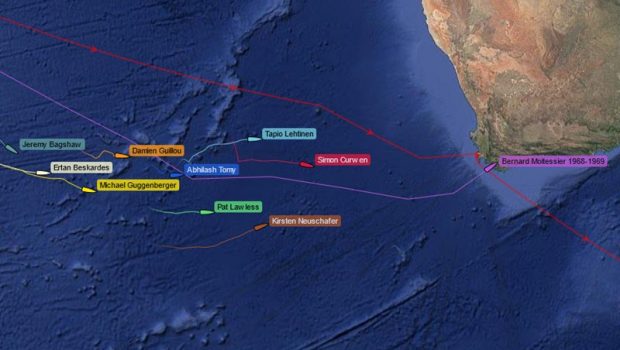

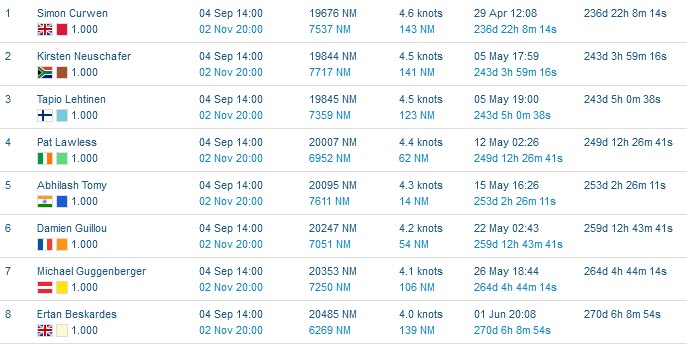

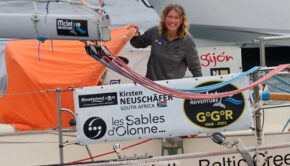
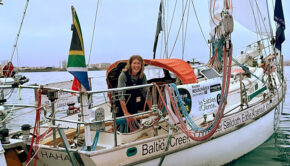
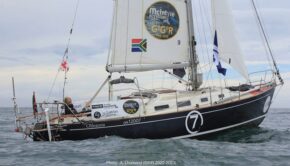
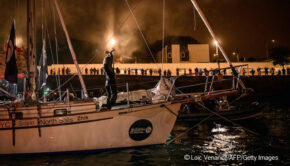
 We’ll keep your information safe.
We’ll keep your information safe.